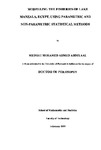MODELLING THE FISHERIES OF LAKE MANZALA, EGYPT, USING PARAMETRIC AND NON-PARAMETRIC STATISTICAL METHODS
| dc.contributor.author | ABDELAAL, MEDHAT MOHAMED AHMED | |
| dc.contributor.other | School of Engineering, Computing and Mathematics | en_US |
| dc.date.accessioned | 2013-11-04T12:56:28Z | |
| dc.date.available | 2013-11-04T12:56:28Z | |
| dc.date.issued | 1999 | |
| dc.identifier | NOT AVAILABLE | en_US |
| dc.identifier.uri | http://hdl.handle.net/10026.1/2572 | |
| dc.description.abstract |
Much attention has been given to the economic aspects of the fisheries in Egypt, while building a statistical or mathematical model for fish production has received little attention. This study is devoted to a comprehensive assessment of Lake Manzala fisheries; past, present and future. Lake Manzala is one of the main fisheries resources in Egypt, and there is evidence that the fisheries have been over-exploited in recent years. The study objectives were to determine the factors that affect fish catches by individual vessels, to compare between parametric and non-parametric models of the fish catches, and to produce a mathematical model of stock behaviour which can be used to suggest policies to manage the Lake Manzala fishery. A new method of estimating the carrying capacity of the lake and intrinsic growth rate of Tilapia and its four species has been developed. Simulation had to be used to get error estimates of the biomass parameter estimates using the new method. Three catch strategies have been investigated and assessed, with discounted utility of future yields. Two ways of modelling individual vessel catches in relation to their effort characteristics, a parametric and non-parametric analysis, have been investigated. Using generalised additive model gave an improved fit to the survey data compared with the parametric analysis. It also gave a lower allowable fleet size which leads to more conservative management policy. A simulation approach was used to investigate the uncertainty in the predicted catches and stock levels, and to give insight into the risks associated with various levels of control. There was no evidence that a management strategy which aimed to fish at maximum sustainable yield would put the stock at risk. | en_US |
| dc.language.iso | en | en_US |
| dc.publisher | University of Plymouth | en_US |
| dc.title | MODELLING THE FISHERIES OF LAKE MANZALA, EGYPT, USING PARAMETRIC AND NON-PARAMETRIC STATISTICAL METHODS | en_US |
| dc.type | Thesis | |
| plymouth.version | Full version: final and full version as approved by the examiners at the time of the award of your degree | en_US |
| dc.identifier.doi | http://dx.doi.org/10.24382/4391 | |
| dc.identifier.doi | http://dx.doi.org/10.24382/4391 |
Files in this item
This item appears in the following Collection(s)
-
01 Research Theses Main Collection
Research Theses Main


